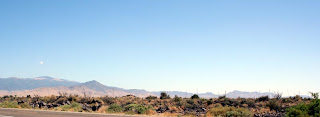 The Myth of You and Me,
The Myth of You and Me, by Leah Stewart. New York: Shaye Areheart Books, 2005.
I found this book on a list of “books you can’t put down,” so I was sure to have it nearby for my knee surgery recovery. Imagine my surprise when, on p. 19, I read:
When I was fourteen we moved to Clovis, New Mexico. My father was in the air force. It was the sixth time I had moved since birth, and this time I was angry. We had left Fairfax County, Virginia, with its proximity to malls and monuments, where everybody’s parents drove the beltway to play some part in the large and mysterious doings of government, for this cow town, dusty brown and flat, like an old postcard. While my friends went on to high school together, I was set adrift again with no one but my family, three passengers afloat on a dirt sea. This is a book about friendship and families and opportunities, both lost and found. It's a book of keen observations that had me nodding, with tears in my eyes, and reaching for my notebook. To top it all off, much of it took place in Clovis and it helped me know my town a bit better.
When I volunteered in an elementary school this past year, some of my fellow volunteers walked over from the neighboring high school every week. Little did they know how curious this older volunteer was about their lives. Here's what Stewart had to say about being a kid in Clovis, and I suspect she got it right on:
I thought of what I could tell him about Clovis—that the fundamentalists signed yearbooks “In His Name” and considered Mormonism a cult, that the kids who wore Megadeth T-shirts and smoked on the edge of school property were called thrashers, that people of Mexican descent were called Spanish, that Spanish kids hung out with white kids or black kids, but usually not with both, that when the fire alarm went off at school early one morning all the girls you otherwise never saw came out of the nursery, cradling their babies close. That after you suffered through the unbearable heat of summer days, you got as a reward a warm and crisp night, that the flatness of the land, the way nothing blocked your view of the sky, made you feel open and expansive, like a deep breath. “It’s okay,” I said.
Now, I'm not much good at writing book reviews that don't sound like those little quotes on the back of the book jacket (astounding! couldn't put it down!) but I want to tell you that I was constantly touched as Stewart told about the lives of these friends. Here are a few more quotes to give you the flavor of the book.
To belong nowhere is a blessing and a curse, like any kind of freedom.
A person is not a suitcase, with a finite number of items to unpack. A person is a world. Look at any photograph—of a stranger, your father, your very best friend. Sometimes the mystery is all you can see.
Maybe I did live an old story, but I couldn’t help but live it as though for the first time. The first time you fall in love, it’s like you’ve created the first love in the universe, and the first time someone you love dies, you grieve the universe’s first death. What does it help to be told that what you feel is nothing new? You want your father’s respect, not a pale copy of all the children who have ever wanted their fathers’ respect, but fiercely, because he’s the only father you’ll ever have.
Okay, reading this book was an astounding experience, and I couldn't put it down.
 According to Wikipedia, a Navajo skinwalker or skin-walker (yee naaldlooshii) is a witch; a shape-shifter who assumes the shape of an animal in order to travel.
According to Wikipedia, a Navajo skinwalker or skin-walker (yee naaldlooshii) is a witch; a shape-shifter who assumes the shape of an animal in order to travel.





















